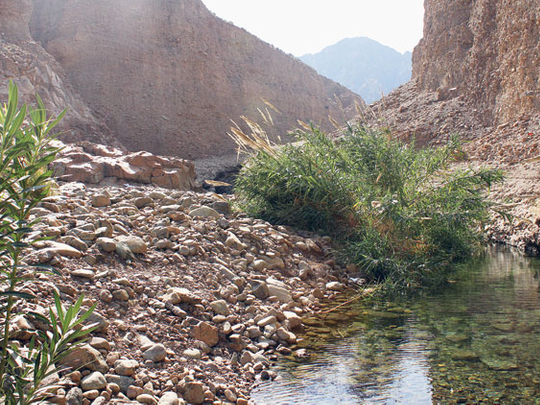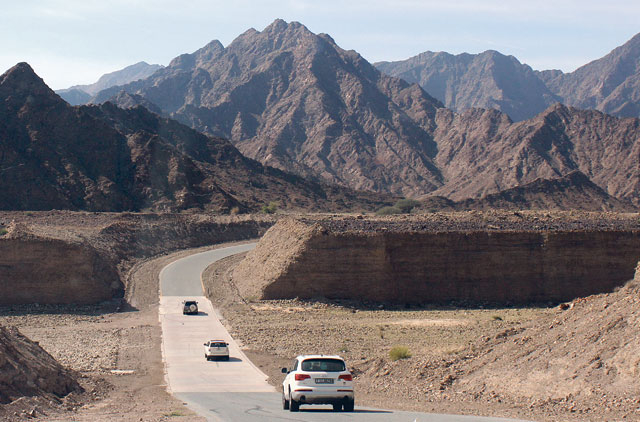
I went on one of the best camping trips ever last weekend in Fujairah. Emirates Wildlife Society, in association with World Wild Fund for Nature (EWS-WWF), organised a special trip to Wadi Wurayah, which is the first protected mountain area in the UAE.
Two friends and I drove for about 90 minutes from Dubai to Fujairah, passing through Sharjah and Ras Al Khaimah, before meeting up with a EWS-WWF team and other eager campers. Driving along the desert was almost surreal because the sand dunes were covered with grass, turning the desert green (an oxymoron it seemed to me).
Wadi Wurayah was officially declared the UAE's first protected mountain area by the Ruler of Fujairah in March 2009. The decree came after the completion of a three-year project launched in 2006 by EWS-WWF and the Fujairah Municipality with the support of HSBC Bank Middle East.
"At the start of the project we discovered that the endangered mountain wildlife was increasingly threatened, either by direct transformation or through unregulated recreational use," explained Christophe Tourenq, EWS-WWF science and research manager, as we prepared for our journey into the wadi. "This decree will go a long way in ensuring the wildlife and area is closely monitored and protected for future generations."
Nature in all its glory
At midday, the group of 20 of us began a very bumpy ride in our 4x4 vehicles deep into Wadi Wurayah, as the rock cliffs of the Hajar mountains towered on each side of us. The wadi is a 129km-square catchment that occupies the northern reaches of Fujairah between the towns of Masafi, Khor Fakkan and Bidiyah.
Due to its permanent water resource, the area has been used by local communities for thousands of years and is home to rare and endangered species such as the Arabian Tahr and Arabian Leopard. The wadi is located within an eco-region (known as the Arabian Highlands and Shrublands), which is one of the WWF Global 200 Eco-regions that regroups the richest, rarest and most distinctive of the earth's natural habitats.
This area reflects the fauna, flora and cultural heritage of the region. It is a hotspot of biodiversity, housing 20 species of mammals, 17 species of reptiles and amphibians, rare plants such as an orchid species unique to the UAE, and trees such as Moringa peregrina, which supports the wildlife with its fruits and a local activity (honey hunting).
Unforgettable sights
I tried taking a video during our ride in the wadi but it was too brutal, although very entertaining. We then left the cars and began an amazing hike in the riverbed. It was certainly not a walk in the park though, as we had to climb very carefully, walk thigh-high through water pools and make big leaps whilst trying not to slip. The five EWS-WWF team members made sure we didn't step too close to the edges when we couldn't help but take a look at the beautiful pools below us, carved in the rocks by water flowing through for millions of years.
"Look here," Tourenq told us while pointing at a small lizard bathing in the sun. A few minutes later, he showed us some footprints, and according to Moaz Sawaf, communication and marketing officer, EWS-WWF, they were fresh prints from an Arabian fox.
Further on, we reached the perfect place for Fujairah geoligist Khaled Shuriqe to give us a short lecture on the area. We were down in the riverbed (with few pools of water here and there) so Shuriqe pointed to the tall rock cliffs on both sides of the wadi. These two types of metamorphic rocks are the result of pressure and heat in the faults, the expert said. One side is composed of volcanic rocks - a mix of dunite, harzburgite and gabbro - combined from magnesium, iron (giving the rocks a reddish colour) and calcium carbonate, dating back from the late cretaceous era (90 million years ago). The formation on the other side comes from sedimentary rocks, including marble and serpentine, accumulated over thousands of years.
Meeting the inhabitants
We continued our adventurous walk until we reached a bat cave, which is supposed to house Muscat mouse tail backs. But as we climbed up to reach the dark cave, we found out that its inhabitants had deserted. Tourenq gave us two possible explanations: Either the climate has been too cold and they've moved to a more sheltered cave or too many people have come by which led them to leave.
It was time for another short lecture on the aquatic life in the wadi. Conservation officer Emma Smart caught a few species from a large pool and placed them in a flat bucket.
She introduced us to Garra barreimiae, a small, dark, catfish-like bottom feeder that is one of two fresh water fish species in the UAE. "These fish are known to jump over a rock from one pool to another if there's a little flow of water," Smart said.
We also saw a bug named water scorpion because of its long dangerous-looking tail which it uses to breathe. Plus dragonfly larvae which climb out of the water onto a rock when they're ready to emerge as an adult out of their casing.
After about three hours of walking and taking in the beauty of the wadi's biodiversity and habitats, we started heading back to the cars. There is a lovely waterfall at the entrance to the wadi, but unfortunately the rocks surrounding the water have been defaced with graffiti.
"You don't need to manage nature, it will do that itself. It's the people you need to manage," Tourenq said.
That's why the wadi project is a long-term initiative. EWS-WWF and the local government are working toward making Wadi Wurayah open to public access with controlled entry. A visitors and awareness centre will be built, offering guided tours and educational activities Daily park rangers will patrol the area to help educate visitors and enforce the protection of this area by monitoring their activities for illegal actions, which will be penalised by fines.
The camping part of the trip then began. We pitched our tents on a flat terrain away from the riverbed and had an incredible dinner. Local friends of our expedition leaders brought us a gargantuan pot with two goats cooked along with rice and side dishes (chick peas and vegetables). They also brought harees, a traditional Emirati dish (like a porridge) consisting of wheat and chicken. We all sat on the ground in a circle and ate with our hands to the sounds of Arabic music.
The night ended around a fire, eating fruits and desserts and sipping tea...












